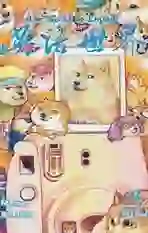The South African Artist Turning Plastic into Portraits南非艺术家化塑料为画像
2024-08-11纳迪娅·利-休伊森/文魏雨萱/译
While other artists might use water-colors or oil paints, Mbongeni Buthelezi uses waste plastics to create highly textured portraits at his studio in Booysens, Johannesburg.
其他艺术家也许会用水彩或油画颜料创作,而姆邦盖尼·布特莱齐却在他位于约翰内斯堡市布伊森斯的工作室里,使用废塑料创作质感极佳的画像。
His medium1 is the plastic litter he collects from local rubbish dumps and city streets. “Animals are dying, fish in the ocean are dying—because of this material and because of us as human beings,” Buthelezi said. “It is us that need to take responsibility.”
他使用的材料是从当地垃圾填埋场和城市街道上收集来的塑料垃圾。“正是因为塑料和我们人类,陆地上的动物正在死去,海里的鱼也在死去。”布特莱齐说,“我们必须为此负责。”
An artist and activist, Buthelezi, 56, first found his talent for the creative as a boy in rural KwaZulu-Natal, South Africa. He sculpted clay figurines of the livestock around his village: cows, horses and goats.
56岁的布特莱齐是一名艺术家和活动家,小时候生活在南非夸祖鲁-纳塔尔省的农村地区,那时的他就发现了自己的创作天赋。他用黏土捏出村子里的牲畜,有奶牛、马和山羊。
“I grew up with my father’s animals, the cattle were an important part of my life,” said Buthelezi. But not everything in this rural setting was natural.
“我和父亲饲养的牲畜一起长大,牛曾是我生活中重要的一部分。”布特莱齐说。但乡村中并非一切都是天然的。
He explained that plastic litter was so common in grazing areas that it became an unwelcome part of the cows’ regular diet. “We would see these cows die because they had eaten plastics,” Buthelezi said.
布特莱齐解释道,塑料垃圾在牧区太常见了,已经成为奶牛日常饮食中有害的一部分。他说:“我们眼睁睁地看着奶牛因误食塑料而死亡。”
Five decades on, South Africa still has a serious plastic pollution problem. In 2018, 107,000 metric tons of plastic waste from South Africa ended up in the marine environment. A 2015 study found that the country was one of the world’s top 20 contributors to marine plastic pollution.
50年了,南非依然有着严重的塑料污染问题。2018年,南非将10.7万吨废弃塑料排入大海。2015年的一项研究发现,南非是世界上造成海洋塑料污染最多的20个国家之一。
With plastic waste growing around the world, Buthelezi is using his work to both highlight and combat the issue.
随着全世界的废弃塑料不断增多,布特莱齐正利用他的作品来强调这个问题并防止其继续恶化。
Practical plastics
有用的塑料
Buthelezi’s use of waste wasn’t always in defense of the environment; he first began using plastic litter for his art because he couldn’t afford more trad-itional mediums.
布特莱齐使用废塑料最开始并不是为了保护环境,而是因为他买不起常规的艺术创作材料。
At 22, when the country was still under apartheid2, he enrolled in full-time classes at a community arts school in Soweto, a township in Johannesburg. He took with him just two blankets, very little money, and a lot of optimism. There he lived in a small room and worked odd jobs between classes to afford rent and food. He had no money for materials.
他22岁那年,南非仍在实行种族隔离制度,他在索韦托(约翰内斯堡的一个黑人小镇)的一所社区艺术学校学习全日制课程。他随身带着的只有两条毯子和非常少的钱,但他十分乐观。在那里,他住着狭小的房间,课余时间靠打零工来支付食宿费用,根本没有余钱来买材料。
“It was the ’80s, and South Africa was facing this transitional phase where politics was very volatile,” said Buthelezi.
“那是上世纪80年代,南非正处在过渡时期,政局十分动荡。”布特莱齐说。
He added that the political climate didn’t offer much opportunity for young Black South Africans trying to build their career, especially those from the townships. The main problem was a lack of funding.
他补充道,南非的政治环境并没有为想在事业上有所建树的黑人青年,尤其是来自黑人小镇的青年,创造什么机会。他们的主要问题是没有资金支持。
Buthelezi explained that there was no formal schooling in the townships, and the community-based institutions, like his college, received no support from the state.
布特莱齐解释道,黑人小镇没有正规的学校教育,以社区为基础的学校,比如他所就读的学校,得不到政府的任何支持。
“The school introduced us to things like collage—using old magazines to create an artwork if you don’t have money for paints,” said Buthelezi. “Without those fancy traditional ways of making art, we expanded our way of looking at art and life.”
“学校让我们初次了解到拼贴画之类的东西,如果你没钱买颜料的话,就用旧杂志创作艺术品。”布特莱齐说,“无法用十分讲究的常规方式进行艺术创作,我们就拓宽自己看待艺术和生活的视野。”
“Next to my studio at the college was a dumping site,” he recalled. “I saw all of these brilliant colors, these ma-terials… and I said to myself, what can I do to make sense of these plastics that are everywhere?”
“在学校,我的工作室隔壁就是一座垃圾场。”他回忆道,“放眼望去,全都是花花绿绿的废料……我就问自己,怎么做才能让这些无处不在的塑料变得有价值呢?”
He began collecting plastic litter to “paint” with in lieu of expensive oil paints. He developed a technique of using an electric heat gun that produced hot air to melt the plastic and then apply it to a recycled canvas. According to Buthelezi this is more environmentally friendly than using flames to melt plastic and doesn’t release noxious fumes into the atmosphere.
他开始收集塑料垃圾来代替昂贵的油画颜料进行“绘画”。他发明了一种技艺,用电热枪喷出的热气熔化塑料,然后将其涂抹到回收利用的画布上。布特莱齐认为,这比用火熔化塑料更环保,而且不会向大气中排放有毒烟雾。
After completing his studies at the African Institute of Art and subsequently the Johannesburg Art Foundation, he went on to achieve an advanced Dip-loma in Fine Arts from the University of the Witwatersrand.
布特莱齐先后在非洲艺术学院和约翰内斯堡艺术基金会完成学业,随后又在金山大学获得了美术专业的高级文凭。
As his career progressed, he thought back to his childhood experiences of plastic and the role plastic pollution played in the death of many of his father’s cows. By the ’90s, Buthelezi was a professional artist, and he was determined to use innovation in art for the good of the planet.
随着职业生涯的发展,他回想起自己童年时与塑料打交道的经历,正是塑料污染导致父亲的许多奶牛死亡。上世纪90年代,布特莱齐成为一名职业艺术家,他决心利用艺术创新为地球造福。
“As an artist, I am the mirror of my society.”
“作为一名艺术家,我是自己所处社会的写照。”
Buthelezi still makes works using the same method of melting waste plastic. The works are figurative and mostly explore the experience of growing up in a South African township. Throughout his career he has used his art to educate and begin conversations on global plastic waste. “The world we live in today can offer us everything we need to make art without manufacturing more,” he said.
布特莱齐如今仍在用熔化废塑料的那套方法创作。他的作品是形象艺术,主要表现他自己在南非一座黑人小镇的成长经历。利用自己的艺术作品开展教育,并就全球塑料垃圾问题展开对话是贯穿他职业生涯的重要命题。他说:“我们今天生活的世界可以为我们提供艺术创作所需要的一切,无须为了创作制造更多的东西。”
Buthelezi has held exhibitions, participated in festivals, led workshops, and taken up artist residencies3 in countries including Germany, the USA, Barbados, Egypt, Australia, and Saudi Arabia.
布特莱齐举办作品展、参加艺术节、组织研讨会,并在德国、美国、巴巴多斯、埃及、澳大利亚和沙特阿拉伯等国驻留工作。
“As an artist I am the mirror of my society,” says Buthelezi. “I’m supposed to reflect on what is happening on the ground where I live.” And for him, what’s “on the ground” is plastic.
“作为一名艺术家,我是自己所处社会的写照。”布特莱齐说,“我应该反映我生活的土地上正在发生的事情。”对他来说,现在“土地上”有的就是塑料。
In March 2023, he spoke at a South African National Science and Technology Forum discussion on plastic innov-ation and at the end of 2023 he participated in an art and environment festival in Abu Dhabi.
2023年3月,布特莱齐在南非国家科技论坛的一场座谈会上,发表了关于塑料创新的讲话。2023年底,他参加了在阿布扎比举办的艺术与环境节。
Although his efforts have won widespread praise, Buthelezi says not everyone has been so supportive. “Some people say, ‘you will run out of plastics one day and then you won’t be able to do your work,’” he said. “They don’t understand that I would be happy if that happened. That is what I’m fighting for!”
尽管布特莱齐的努力赢得了广泛赞誉,但他说并不是所有人都那么支持他的做法。“有些人说:‘总有一天你会用尽塑料的,那时你就不能创作了。’”他说,“他们根本不懂,要是真有那么一天,我会非常高兴。那正是我奋斗的目标!”
(译者为“《英语世界》杯”翻译大赛获奖者;单位:广东外语外贸大学)
1 medium(文艺创作中使用的)材料、形式。
2 apartheid种族隔离,前南非政府自1948年至1994年推行的政策。在南非种族隔离时期,只有黑人居住的镇称township。
3 residency(艺术家、作家、音乐家为某机构工作的)驻留时间,驻留期。
